Doubtful Sound

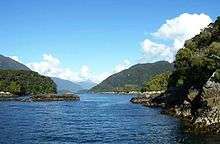
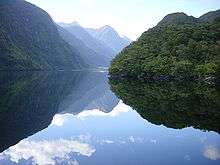
Doubtful Sound / Patea is a very large and naturally imposing fiord (despite its name) in Fiordland, in the far south west of New Zealand. It is located in the same region as the smaller but more famous and accessible Milford Sound. It took second place after Milford Sound as New Zealand's most famous tourism destination.[1]
History
Doubtful Sound was named 'Doubtful Harbour' in 1770 by Captain Cook, who did not enter the inlet as he was uncertain whether it was navigable under sail.[2] It was later renamed Doubtful Sound by whalers and sealers, although it is not technically a sound but a fiord.
A Spanish scientific expedition commanded by Alessandro Malaspina visited Doubtful Sound in February 1793 to conduct experiments measuring the force of gravity using a pendulum, a part of the effort to establish a new metric system.[3] The officers of the expedition, which included Felipe Bauzá y Cañas, a cartographer,[4] also made the first chart of the entrance and lower parts of the Sound, naming features of it. Today these form a unique cluster of the only Spanish names on the map of New Zealand: Febrero Point, Bauza Island and the Nee Islets, Pendulo Reach, and Malaspina Reach.[5]
Following the passage of the Ngai Tahu Claims Settlement Act 1998, the name of the fiord was officially altered to Doubtful Sound / Patea.[6]
Geography
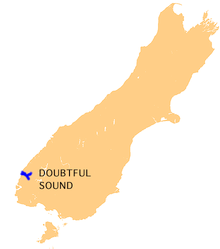
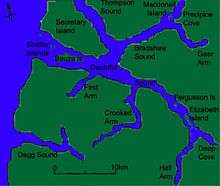
There are three distinct arms to the sound, which are all to the south of the main fiord. From the major conflux of water just south of Secretary Island, these arms are:
- First Arm
- Crooked Arm, which is roughly halfway along the sound
- Hall Arm, which branches off from the Sound's terminus at Deep Cove.
The Sound is the site of several large waterfalls, notably Helena Falls at Deep Cove and the Browne Falls, which have a fall of over 600 metres (2,000 ft). The steep hills are known for their hundreds of waterfalls during the rainy season.
The last quarter of the sound closest to the sea is dominated by islands, the major one being Secretary Island. At the southernmost tip of the island, Doubtful Sound opens up as a confluence of 5 bodies of water. From the western seaward end and going clockwise, these are:
- Seaward end of Doubtful Sound, sometimes known as "the gut"
- Thompson Sound
- Bradshaw Sound
- Continuation of Doubtful Sound to Deep Cove
- First Arm
Access to the sound is either by sea or by the Wilmot Pass road from the Manapouri Power Station. Most areas of the sound itself are accessible only by sea, however, as the road network in this area of New Zealand is sparse or nonexistent, as is the human population.
Charles John Lyttelton, 10th Viscount Cobham, Governor-General of New Zealand (1957–1962) wrote about this part of Fiordland:
- "There are just a few areas left in the world where no human has ever set foot. That one of them should be in a country so civilized and so advanced as New Zealand may seem incredible, unless one has visited the south-west corner of the South Island. Jagged razor backed mountains rear their heads into the sky. More than 200 days of rain a year ensure not a tree branch is left bare and brown, moss and epiphytes drape every nook. The forest is intensely green. This is big country... one day peaceful, a study in green and blue, the next melancholy and misty, with low cloud veiling the tops... an awesome place, with its granite precipices, its hanging valleys, its earthquake faults and its thundering cascades."
Parts of the sound on the west side of Elizabeth Island are protected by the Taipari Roa (Elizabeth Island) Marine Reserve.
The narrow, shallower area of the sound between Bauza and Secretary Island offers more shelter than areas further to the west and towards the sea. It is a popular fishing and mooring location and is a haven for crayfish. It is often referred to as "the gut".
Flora and fauna
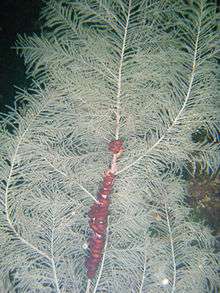
Doubtful Sound (like many of the fiords in the area) is unusual in that it contains two distinct layers of water that scarcely mix. Depending on rainfall the night before, the top 2–10 metres (5–35 ft) is fresh water, fed from the high inflows from the surrounding mountains, and stained brown with tannins from the forest. Below this and partially insulated by the fresh water above is a layer of warmer, heavy, saline water from the sea. The dark tannins in the fresh water layer make it difficult for light to penetrate. Thus, many deep-sea species grow in the comparatively shallow depths of the Sound.[7] Such species include black coral (Antipatharia fiordensis), which is normally found at depths of 30–40 metres (100–130 ft) but can be found at just 10 metres (35 ft) in Doubtful Sound and is within the range of qualified recreational divers.
The catchment basin of Doubtful Sound is generally steep terrain that is heavily forested except for locations where surface rock exposures are extensive. Nothofagus trees are dominant in many locations. In the understory there are a wide variety of shrubs and ferns, including the crown fern, Blechnum discolor.[8]
The fiord is home to one of the southernmost populations of bottlenose dolphins. The Doubtful Sound bottlenoses have formed a very insular subgroup of only about 70 individuals, with none having been observed to leave or enter the Sound during a multiyear monitoring regime. Their social grouping is thus extremely close, which is also partly attributed to the difficult and unusual features of their habitat, which is much colder than the habitats of other bottlenose groups and is also overlaid by the freshwater layer.[9] Recently (2000s), there has been growing concern that the population is in significant decline, with calf survival rates having halved, as well as being noticeably lower than in captivity or in other New Zealand environments. The reasons for this are unclear, though increased tourism and the fresh-water discharge from the Manapouri Power Station (see Hydroelectricity section below) are considered potential causes.[7]
Other wildlife to be found in Doubtful Sound includes fur seals and penguins, or even large whales.[10] Southern right whales and humpback whales are the most frequently seen especially the later.[11][12] Others include minke whale, sperm whale and some giant beaked whales[13]). Orcas (killer whales) and long-finned pilot whales can be found also. The waters of Doubtful Sound are also home to an abundance of sea creatures, including many species of fish, starfish, sea anemones, and corals. It is perhaps best known for its black coral trees which occur in unusually shallow water for what is normally a deep-water species. The sound has been identified as an Important Bird Area by BirdLife International because it is a breeding site for Fiordland penguins.[14]
Hydroelectricity
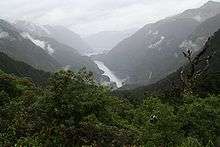
Deep Cove (45°27′S 167°09′E / 45.450°S 167.150°E), an arm of Doubtful Sound, is the site of discharge of water from the Manapouri Power Station's tailrace tunnels. Deep Cove, like the rest of Fiordland, is a unique and mostly pristine environment. The discharge of clear fresh water has affected fauna and flora by letting light into the lower layers of the sound.[7] Nevertheless, this is an area naturally high in fresh water inflows (7.6 metres (24 ft 11 in) of rain falls annually).
Tourism
Unlike the more easily accessible Milford Sound, it is not possible to drive to Doubtful Sound. However, many visitors do manage to take a boat cruise to Doubtful Sound. The less common way to access Doubtful Sound is by sea. However, there are some boat cruises that operate out of Manapouri. They first take a boat across Lake Manapouri and then a bus across to Wilmot Pass to Doubtful Sound. The tour companies offer a day option out of Te Anau/Manapouri or an overnight option. Another option is to stay in Queenstown and drive to Manapouri. There are some companies who offer overnight cruises. They halt their boat in a place and they give an option of kayaking and bird watching. In the morning they stop their engine and in the eerie silence you can hear the sounds of nature which is magical.
References
- ↑ Real Journeys rapt with Kiwi Must-Do's - Scoop Independent News, Tuesday 13 February 2007
- ↑ Cook's Voyages (from Te Ara Encyclopedia of New Zealand. Accessed 2008-09-12.)
- ↑ “Puerto del Pendulo, Doubtful Sound: The Malaspina Expedition’s Visit to New Zealand in Quest of the True Figure of the Earth”, The Globe, no.65, 2010, pp.1-18. Downloadable at: http://search.informit.com.au
- ↑ Doubtful Sound (from Te Ara Encyclopedia of New Zealand. Accessed 2008-09-12.)
- ↑ Science and Spycraft: The Malaspina Expedition in New Zealand and New South Wales, 1793 - Robert J. King, via Mains’l Haul, A Journal of Pacific Maritime History, San Diego, Vol 41 No. 4 & 42, No. 1, Fall/Winter 2006, Pages 76-87
- ↑ "Ngai Tahu Claims Settlement Act 1998". Retrieved 28 March 2016.
- 1 2 3 A Doubtful future - New Zealand Listener, 27 September 2008
- ↑ C. Michael Hogan. 2009. Crown Fern: Blechnum discolor, Globaltwitcher.com, ed. N. Stromberg
- ↑ Bottlenose dolphins (from Te Ara Encyclopedia of New Zealand. Accessed 2008-09-12.)
- ↑ http://www.backpackersnews.co.nz/index.php?page=whale-sightings-up/
- ↑ https://www.odt.co.nz/regions/queenstown-lakes/whale-watchers-dream
- ↑ http://www.fmg.org.nz/content/humpback-whale-migration-0
- ↑ http://fiordlandkindy.blogspot.com/2009/04/whales-at-doubtful-sound.html/
- ↑ BirdLife International. (2012). Important Bird Areas factsheet: Doubtful Sound. Downloaded from http://www.birdlife.org on 2012-02-18.
| Wikimedia Commons has media related to Doubtful Sound. |
Coordinates: 45°18′S 166°59′E / 45.300°S 166.983°E